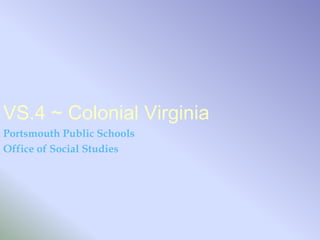
Vs4 review, 2008
- 1. VS.4 ~ Colonial Virginia Portsmouth Public Schools Office of Social Studies
- 2. • Plantation ~ a large farm • Economy ~ Use of money to produce and buy goods and services • Slave ~ a person who is owned by another person and has no freedom or rights • Cash Crop ~ A crop that is grown to sell for money rather than to be consumed or used for processing a good
- 3. The Economy of Virginia depended on • Agriculture was a primary source of wealth Tobacco became the most profitable agricultural product and was sold in England as a cash crop.
- 5. The successful planting of tobacco: • Depended on a reliable and inexpensive/cheap source of labor • Large numbers of Africans were brought to the colony against their will to work on slaves on the plantations. • The Virginia Colony became dependent on slave labor, and the dependence lasted a long time.
- 6. Cultural landscapes • Whenever people settle in an area, they change the culture and landscape to reflect their beliefs, customs, and architecture. • Examples of cultural landscapes: – Barns – Homes – Places of Worship
- 7. Places that reflect culture: • Richmond ~ English Culture • Roanoke ~ American Indian RichmondRoanoke
- 8. What groups moved to Virginia? Where did they live? • The English settled primarily in the Tidewater and Piedmont Regions
- 9. • Germans and Scot-Irish settled primarily in the Shenandoah Valley, which was along a migration route. What groups moved to Virginia?
- 10. • Africans settled primarily in the Tidewater and Piedmont Regions where agriculture required much labor. What groups moved to Virginia?
- 11. • American Indians primarily settled in the Tidewater, Piedmont and Appalachian Plateau Regions where their traditional homelands were. • Prior to the arrival of the settlers, American Indians lived throughout Virginia. After the settlers arrive, most were forced inland. What groups moved to Virginia?
- 12. Cultural Virginia Map ~ Name the group that settled in each region. Green ~ Yellow ~ Pink ~ Blue ~
- 13. Migration and living in new areas caused people to adapt old customs to their new environment. The Virginia culture reflected Indian, European and African cultures.
- 14. On the Move!!! • What are some factors that influenced the move of the capital from Jamestown to Williamsburg?
- 15. All about Jamestown What did they think they had at Jamestown? •Location could easily be defended from attack •Deep Enough for ships to dock •Good supply of fresh water Why did they leave Jamestown? •Water was contaminated •Dirty living conditions caused diseases •Fire destroyed wooden buildings at Jamestown •Williamsburg was at a higher elevation.
- 16. Why did they move from Williamsburg to Richmond?
- 17. Factors relating to the move to Richmond… • Population was moving westward • Richmond was a more central location • The move increased the distance from attack by the English/British (Revolutionary War)
- 18. Since Money was not commonly used, what forms of exchange were used in the Virginia Colony? • Few people had paper money and/or coins to use to buy/purchase goods and services. • Barter was commonly used instead of money – Barter is a trade exchanging goods and services without the use of money
- 19. Tobacco • Tobacco was used as money. • A Tobacco farmer could use his tobacco to pay for goods and services.
- 20. Credit • Farmers and other consumers could also buy goods and services on credit and pay their debts when their crops were harvested and sold.
- 21. Terms to Know • Money ~ a medium of exchange (currency includes coins and paper bills) • Ledger ~ a record book of financial activity • Barter ~ trading or exchanging goods and services without the use of money • Credit ~ buying a good or service now and paying for it later • Debt ~ a good or service owed to another • Savings ~ money put aside to use at a later time
- 22. People living in Colonial Virginia: • Depended on natural, human, and capital resources to produce the goods and services they needed. Human resources are people working to produce goods and services. Natural resources are materials that come from nature (water, soil, wood, coal). Capital resources are goods made by people and used to produce other goods and services (machines, tools, buildings).
- 23. Food Food Choices were limited. Meals were made of local produce and meats. Housing Most people lived in one room homes with dirt floors. Some people (farmers) lived in large houses. Clothing Households made their own clothes. Most clothing was made of cotton wool and leather.
- 24. How did people in Virginia live? • Most white Virginian’s made their living from the land as small farmers. A few owned large farms (plantations). • Most enslaved African Americans worked tobacco, crops, and livestock. Enslaved African Americans had no rights. • Many free African Americans owned their own businesses and properties, but were denied most rights.